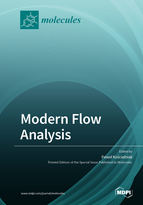Modern Flow Analysis
A special issue of Molecules (ISSN 1420-3049). This special issue belongs to the section "Analytical Chemistry".
Deadline for manuscript submissions: closed (29 February 2020) | Viewed by 45647
Special Issue Editor
Interests: flow analysis; forensic chemistry; environmental chemistry; green analysis; analytical calibration; interference effects; optimization methods
Special Issues, Collections and Topics in MDPI journals
Special Issue Information
Dear Colleagues,
Flow analysis (FA), invented successfully in the middle of 1950s, is a well-recognized and systematically developed branch of analytical chemistry. In FA systems, the analyzed sample can be processed through various physicochemical operations, including extraction, preconcentration or transformation into a chemical form most suitable for the detection used. The flow mode allows a sample to be prepared in a fast, low-cost, safe and efficient way. In addition, due to the mechanization and automation of FA processes, the final analytical results are as a rule more reliable than those obtained under non-flow conditions.
For years, special interest has been focused on instrumental progress in FA. It has been proved that samples can be efficiently treated not only in the continuous flow mode but also in the form of individual segments injected to the carrier stream. In order to decrease the sample and reagent consumption, the concepts of multisyringe and multicommutated flow systems have been introduced into analytical practice. Advances in the field of new materials have been used, amongst other things, to construct original modern detectors dedicated to measurements in the flow mode.
The last FA developments are characterized by specific features that are oriented, in general, towards “green” analytical chemistry. For instance, the gradient technique—based on the idea that the particular points of a single injection peak can be a sufficiently rich source of analytical information—is again noticed and applied. Different micro-extraction liquid–liquid and solid–liquid techniques have been ingeniously adapted to flow conditions, making possible operation with a sample drop. The tendency to make flow systems miniaturized and integrated is expressed by lab-on-valve (LOV) devices, which work sequentially to process a sample in different ways with micro-volumes of reagents. In addition, low-cost flow systems are increasingly designed using either 3D-printing technology or using paper as a body of liquid movement in lab-on-paper (LOP) devices.
I warmly invite members of the “flow family” to submit their original contributions to this Special Issue in order to present the above (and additional) modern aspects of flow analysis with special attention to those that make analytical procedures more environmentally safe and friendly.
We would be delighted if you could respond to confirm your contribution and the proposed title by 31 October 2019.
Prof. Dr. Pawel Koscielniak
Guest Editor
Manuscript Submission Information
Manuscripts should be submitted online at www.mdpi.com by registering and logging in to this website. Once you are registered, click here to go to the submission form. Manuscripts can be submitted until the deadline. All submissions that pass pre-check are peer-reviewed. Accepted papers will be published continuously in the journal (as soon as accepted) and will be listed together on the special issue website. Research articles, review articles as well as short communications are invited. For planned papers, a title and short abstract (about 100 words) can be sent to the Editorial Office for announcement on this website.
Submitted manuscripts should not have been published previously, nor be under consideration for publication elsewhere (except conference proceedings papers). All manuscripts are thoroughly refereed through a single-blind peer-review process. A guide for authors and other relevant information for submission of manuscripts is available on the Instructions for Authors page. Molecules is an international peer-reviewed open access semimonthly journal published by MDPI.
Please visit the Instructions for Authors page before submitting a manuscript. The Article Processing Charge (APC) for publication in this open access journal is 2700 CHF (Swiss Francs). Submitted papers should be well formatted and use good English. Authors may use MDPI's English editing service prior to publication or during author revisions.
Keywords
- micro-extraction techniques
- separation and preconcentration techniques
- miniaturized flow systems
- LOV systems
- LOP systems
- gradient technique
- natural reagents
- one-standard calibration procedures
- flow titration
- flow detectors
Related Special Issues
- Modern Flow Analysis II in Molecules (12 articles)
- Modern Flow Analysis III in Molecules







